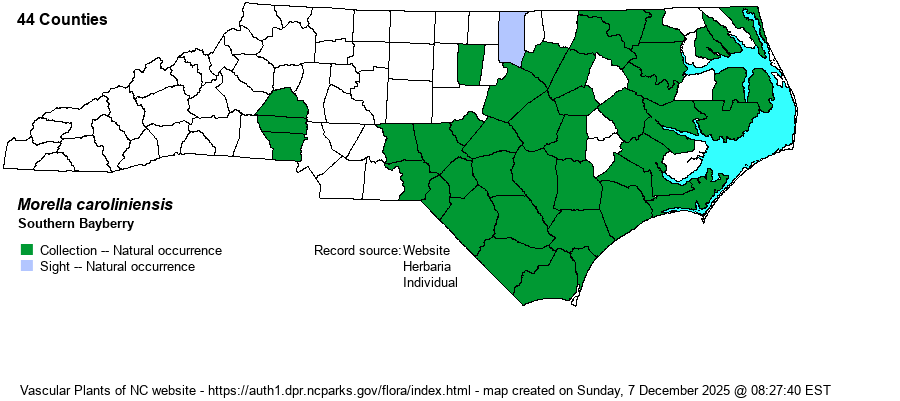| Section 6 » Order Myricales » Family Myricaceae |
Show/Hide Synonym
| taxonName | relationship | relatedTaxonName | relatedTaxonRefText | relComments |
|---|
|
|
|
| Morella caroliniensis | = | Myrica heterophylla | Gleason and Cronquist (1991) | | | Morella caroliniensis | = | Myrica heterophylla | Flora of North America (1993b, 1997, 2000, 2002a, 2002b, 2003a, 2004b, 2005, 2006a, 2006b, 2006c, 2007a, 2009, 2010) | | | Morella caroliniensis | = | Myrica heterophylla | Radford, Ahles, and Bell (1968) | | | Morella caroliniensis | = | Myrica heterophylla | Wofford (1989) | | | Morella caroliniensis | = | Myrica heterophylla | | | | Morella caroliniensis | > | Myrica heterophylla var. heterophylla | Fernald (1950) | | | Morella caroliniensis | > | Myrica heterophylla var. curtissii | Fernald (1950) | | | Morella caroliniensis | < | Myrica pensylvanica | Gleason (1952) | | | Morella caroliniensis | < | Cerothamnus carolinensis | Small (1933, 1938) | (also see Morella pensylvanica) | | Morella caroliniensis | = | Myrica caroliniensis | Wunderlin & Hansen Flora of Florida (3) | | | Morella caroliniensis | < | Morella caroliniensis | Kubitzki in Kubitzki, Rohwer, & Bittrich (1993). | (also see Morella pensylvanica) | | Source: Weakley's Flora |
|
| Author | (P. Miller) Small | |
| Distribution | Occurs throughout the Coastal Plain. Present barely into the eastern edge of the Piedmont, as well as scattered in the southern Piedmont. Occurs west to Orange and Catawba counties, though absent from most counties between these.
This is a Coastal Plain species ranging north to NJ and far eastern PA; and south to central FL, the Gulf Coast, and eastern TX. It does occur into the Piedmont and foothill areas of GA, AL, and southern AR.
| |
| Abundance | Fairly common to common in the Coastal Plain, more numerous in the Sandhills and the southern coastal counties than in the northern portion. Rare at best in the Piedmont portion of the range. | |
| Habitat | This is a species characteristic of pocosins and bays, and other blackwater or acidic wetlands. It is often seen in Sandhill streamhead pocosins, but it also occurs in extensive peat-based pocosins, wet pine flatwoods, savanna margins, and other peaty or wet sandy soils. It is not usually found in brownwater swamps or bottomlands or other rich soil sites. | |
| Phenology | Blooms mostly in April, and fruits from August to October. | |
| Identification | This is a medium-sized evergreen shrub growing to an average height of 5-6 feet, and often as wide or wider. The alternate leaves are oblanceolate (wider near the tip) and have several teeth toward the tip; the lower and middle portions of the blade are entire (as are other species in the genus Morella, as well). The leaves average about 3 inches long and about 1–1.5 inches wide, and are somewhat thick and leathery. It can be easily confused with Common Waxmyrtle (M. cerifera), which often grows with it or near it; however, Southern Bayberry has wider and somewhat thicker leaves, and typically has brown or blackish twigs. Waxmyrtle has narrower and thinner leaves, and the twigs are usually light gray. The pale blue, ball-like fruits are a bit larger than those of Waxmyrtle, as well. | |
| Taxonomic Comments | All species in the genus Morella were traditionally placed in the genus Myrica until fairly recently. In addition, this species was formerly known (as in RAB 1968) as Myrica heterophylla.
| |
| Other Common Name(s) | Evergreen Bayberry, Small Bayberry, Pocosin Bayberry | |
| State Rank | S5 | |
| Global Rank | G5 | |
| State Status | | |
| US Status | | |
| USACE-agcp | FACW link |
| USACE-emp | FAC link |

